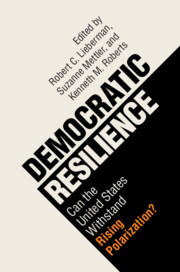Book contents
- Democratic Resilience
- Democratic Resilience
- Copyright page
- Dedication
- Contents
- Figures
- Tables
- Contributors
- Acknowledgments
- Part I Why Might Polarization Harm Democracy?
- Part II Political Institutions in Polarized Times
- Part III Social Polarization and Partisanship
- 7 The Social Roots, Risks, and Rewards of Mass Polarization
- 8 The Great White Hope
- 9 The Religious Sort
- 10 Weaponized Group Identities and the Health of Democracy
- Part IV Vicious Circles? The Relationship between Polarized Behavior and Institutions
- Part V Can Political Action Save Democracy in Polarized Times?
- Index
8 - The Great White Hope
Threat and Racial Resilience in Trump’s America
from Part III - Social Polarization and Partisanship
Published online by Cambridge University Press: 20 November 2021
- Democratic Resilience
- Democratic Resilience
- Copyright page
- Dedication
- Contents
- Figures
- Tables
- Contributors
- Acknowledgments
- Part I Why Might Polarization Harm Democracy?
- Part II Political Institutions in Polarized Times
- Part III Social Polarization and Partisanship
- 7 The Social Roots, Risks, and Rewards of Mass Polarization
- 8 The Great White Hope
- 9 The Religious Sort
- 10 Weaponized Group Identities and the Health of Democracy
- Part IV Vicious Circles? The Relationship between Polarized Behavior and Institutions
- Part V Can Political Action Save Democracy in Polarized Times?
- Index
Summary
Donald Trump has polarized the country more than any other time in the last 75 years. What are the forces that pushed him into the Oval Office? Further, what are the implications, if any, of his election? Drawing on prior work on the Tea Party movement, when we put Trump’s victory in historical context of reactionary movements of the past, his election is simply an extension of a process that began with the Know Nothing Party of the 19th Century. We demonstrate that Trump’s rise, like the formation of other reactionary movements, was fueled by a sense of existential threat: the belief that “real American” culture is under siege. Unlike other recent accounts of Trump, we go a step further to explore another application of threat: the threat the election of the 45th president posed to the progress of people of color (POC). We demonstrate that the Trump movement represented threat to racial minorities who were motivated to vote against Trump because of perceived racism, above and beyond ideology or partisanship. Finally, we conclude by demonstrating that for both groups, threat was a mobilizing force with both White Trump supporters and POC Trump opponents reporting heightened rates of political participation in 2016. We end interrogating the proposition that Trump is really “killing” American democracy. To us, the mobilization of POC suggests otherwise, something borne out in results of the 2020 election cycle.
- Type
- Chapter
- Information
- Democratic ResilienceCan the United States Withstand Rising Polarization?, pp. 195 - 225Publisher: Cambridge University PressPrint publication year: 2021
- 20
- Cited by



